Belatedly, I’ve had time to sit down with the 2021 Primary results. Here are some observations.
In November, Philadelphia will elect eight new judges on the Court of Common Pleas. After the May Primary, we know almost certainly who those judges will be; the Democratic nominees will all win.
All eight Democratic nominees are Recommended by the Bar, three Highly. Surprisingly, they don’t include the person in the number one ballot position. And they won with a wide diversity of maps.
View code
library(dplyr)
library(tidyr)
library(ggplot2)
devtools::load_all("../../admin_scripts/sixtysix/")
ballot <- read.csv("../../data/common_pleas/judicial_ballot_position.csv")
res <- readxl::read_xlsx("C:/Users/Jonathan Tannen/Downloads/2021_primary (1).xlsx")
res <- res %>%
pivot_longer(
cols=`JUSTICE OF THE\r\nSUPREME COURT DEM\r\nMARIA MCLAUGHLIN`:`QUESTION #5\r\nNO`,
names_to="candidate",
values_to="votes"
)
names(res) <- gsub("(\\r|\\n)+", " ", names(res))
names(res) <- gsub("\\s", "_", tolower(names(res)))
res$vote_type <- case_when(
res$vote_type == "E" ~ "Election Day",
res$vote_type == "M" ~ "Mail",
res$vote_type == "P" ~ "Provisional"
)
res_cp <- res %>%
filter(
grepl("^JUDGE OF THE\r\nCOURT OF COMMON PLEAS DEM\r\n", candidate)
) %>%
mutate(
candidate = gsub("^JUDGE OF THE\r\nCOURT OF COMMON PLEAS DEM\r\n","", candidate)
)
res_cp <- res_cp %>%
left_join(ballot %>% filter(year == 2021) %>% mutate(candidate = toupper(name))) %>%
mutate(name=format_name(name))
assertthat::assert_that(
res_cp %>% filter(is.na(name)) %>% with(all(candidate == "Write-in"))
)
res_type <- res_cp %>%
filter(!is.na(name)) %>%
group_by(name, vote_type, rownumber, colnumber, philacommrec, dcc, inq) %>%
summarise(votes=sum(votes)) %>%
group_by(vote_type) %>%
mutate(pvote = votes/sum(votes))View code
res_total <- res_type %>%
group_by(name, rownumber, colnumber, philacommrec, dcc, inq) %>%
summarise(votes=sum(votes), .groups="drop") %>%
mutate(pvote = votes/sum(votes))
ggplot(
res_total %>% arrange(votes) %>% mutate(winner = rank(-votes) <= 8),
aes(y=rownumber, x=colnumber)
) +
geom_tile(
aes(fill=pvote*100, color=winner),
size=2
) +
geom_text(
aes(
label = ifelse(philacommrec==1, "R", ifelse(philacommrec==2,"HR","")),
x=colnumber+0.45,
y=rownumber+0.45
),
color="grey70",
hjust=1, vjust=0
) +
geom_text(
aes(
label = ifelse(dcc==1, "D", ""),
x=colnumber-0.45,
y=rownumber+0.45
),
color="grey70",
hjust=0, vjust=0
) +
geom_text(
aes(label = sprintf("%s\n%0.1f%%", name, 100*pvote)),
color="black"
# fontface="bold"
) +
scale_y_reverse(NULL) +
scale_x_continuous(NULL)+
scale_fill_viridis_c(guide=FALSE) +
scale_color_manual(values=c(`FALSE`=NA, `TRUE`="yellow"), guide=FALSE) +
annotate(
"text",
label="R = Recommended\nHR = Highly Recommended\nD = DCC Endorsed",
x = 1.6,
y = 6,
hjust=0,
vjust=0.5,
color="grey70"
) +
theme_sixtysix() %+replace%
theme(
panel.grid.major=element_blank(),
axis.text=element_blank()
) +
ggtitle(
"Common Pleas Results",
"2021 Democratic Primary, arranged as on the ballot. Winners are outlined."
)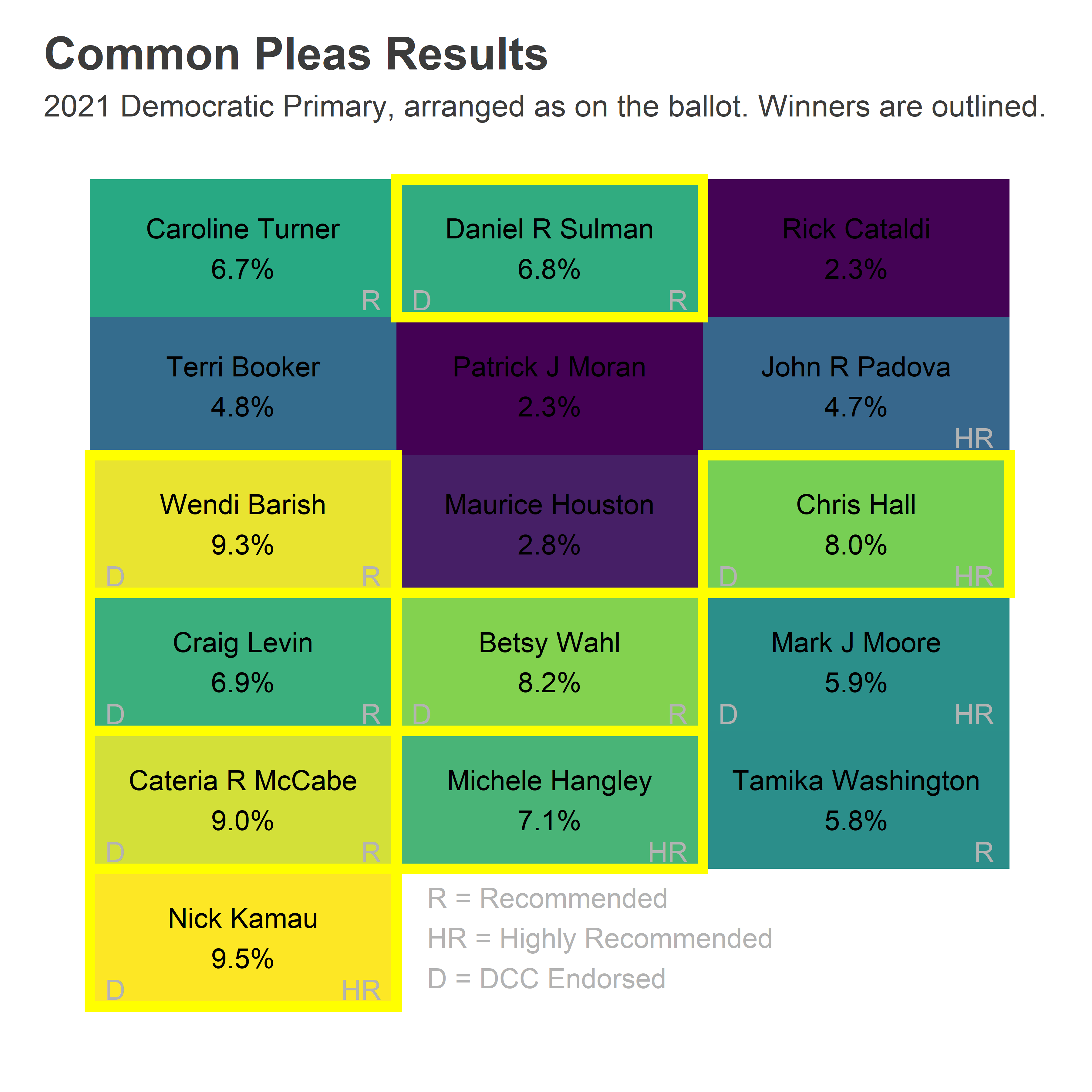
Four candidates won in the first column, three in the second, and one in the third. Three winners were Highly Recommended by the Bar, including Michele Hangley in the second column and Chris Hall in the third, but by itself that rating wasn’t sufficient: John Padova and Mark Moore failed to capitalize on it. There’s some additional work needed to use it to your advantage.
The candidates’ maps are diverse. Nick Kamau and Cateria McCabe won everywhere, though slightly stronger in the Black wards of West and North Philly (and decidedly not the Northeast). Wendi Barish also won everywhere, slightly stronger in Center City and its ring. Betsy Wahl, Chris Hall, and Michele Hangley all won thanks to their strength in the Wealthy Progressive ring around Center City and in Chestnut Hill and Mount Airy. Craig Levin did the opposite, winning the Northeast and West and North Philly, presumably on the strength of his DCC endorsement. And Dan Sulman was the eighth and final winner, with the bright yellow 53rd ward just enough to push him through, where his sister is the Ward Leader.
View code
library(sf)
divs <- st_read("../../data/gis/warddivs/202011/Political_Divisions.shp") %>%
mutate(warddiv = pretty_div(DIVISION_N))wards <- st_read("../../data/gis/warddivs/201911/Political_Wards.shp") %>%
mutate(ward=sprintf("%02d", asnum(WARD_NUM)))res_ward_type <- res_cp %>%
mutate(ward = substr(division, 1, 2)) %>%
group_by(ward, name, vote_type) %>%
summarise(votes=sum(votes)) %>%
group_by(vote_type) %>%
mutate(pvote=votes/sum(votes))
res_ward <- res_ward_type %>%
group_by(ward, name) %>%
summarise(votes=sum(votes)) %>%
group_by(ward) %>%
mutate(pvote=votes/sum(votes))
res_ward <- left_join(wards, res_ward)
candidate_order <- res_total %>% arrange(desc(votes)) %>% with(name)
ggplot(
res_ward %>%
filter(!is.na(name)) %>%
mutate(name=factor(name, levels=candidate_order))
) +
geom_sf(aes(fill=100*pvote), color=NA) +
scale_fill_viridis_c("Vote %") +
facet_wrap(~ name) +
theme_map_sixtysix() %+replace% theme(legend.position="right") +
ggtitle("Common Pleas Results", "2021 Democratic Primary")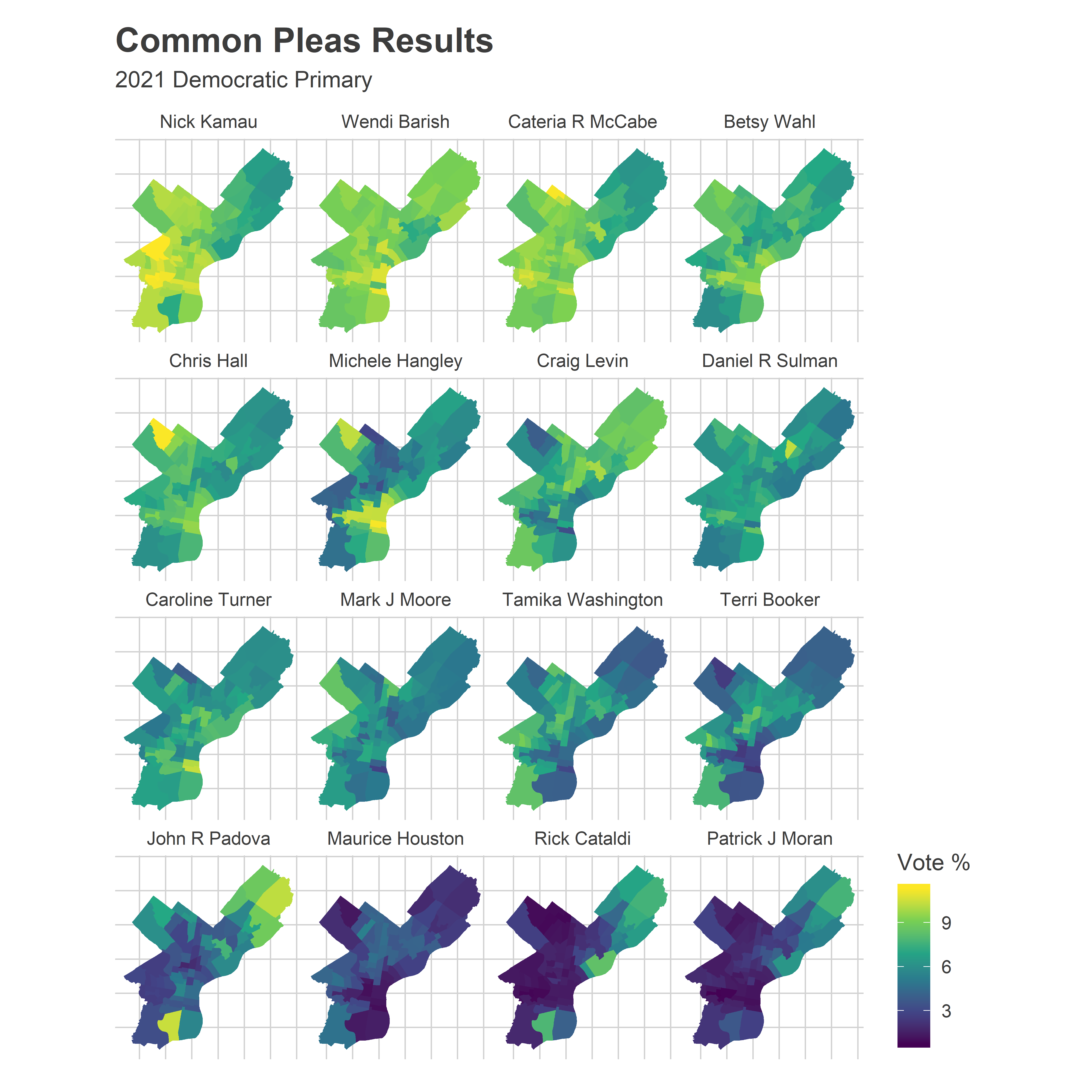
Caroline Turner was the first runner up, and the first candidate to fail to win from the top ballot position since at least 2007 (which is all the ballot layouts I can find). But she did really well in the 1st and 2nd Wards, which now deserve a name.
The Reclaim Wards
When clicking through the results online, I saw a cut that made me laugh out loud.
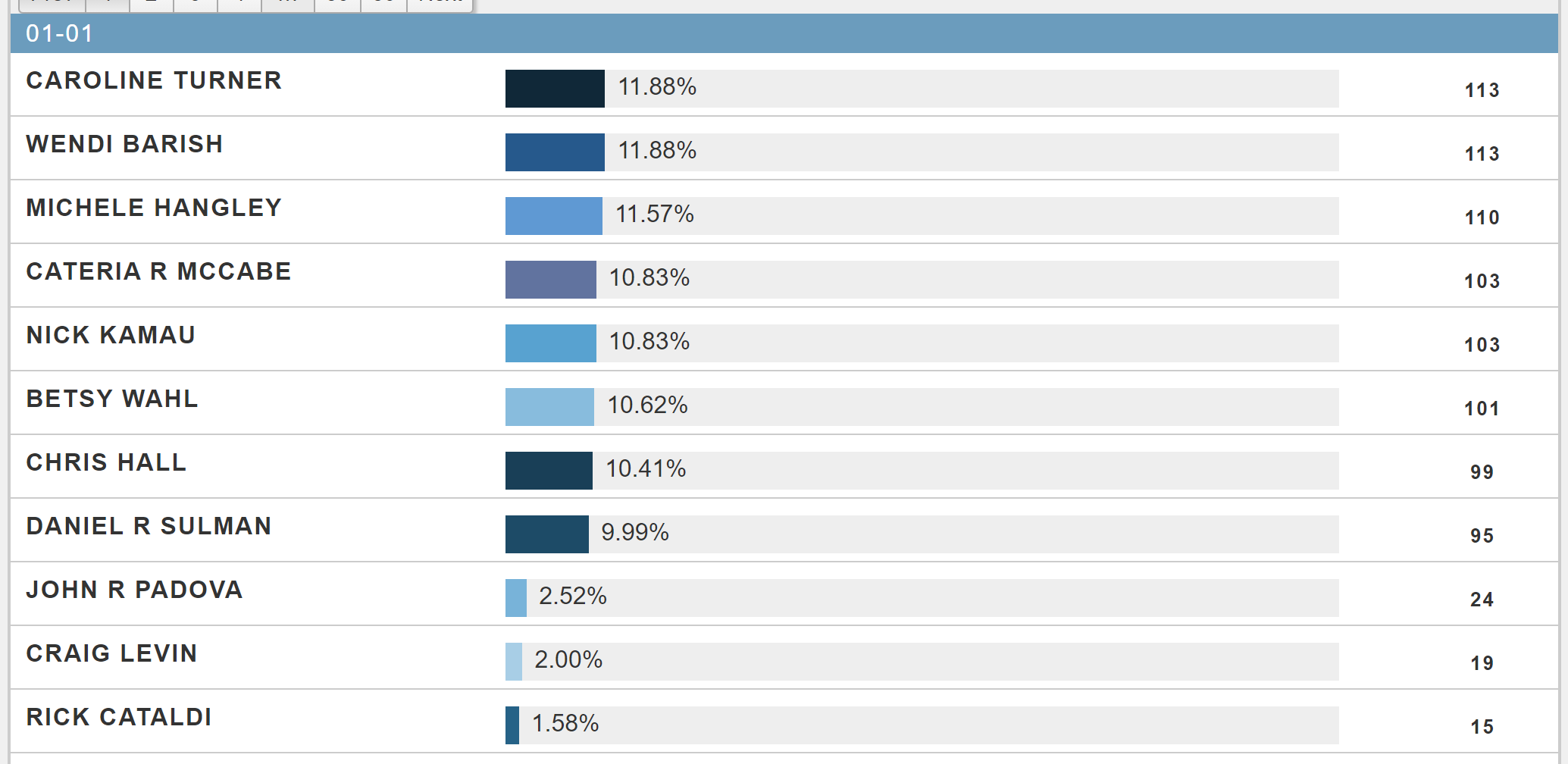
Results from Division 01-01
The top eight winners in 01-01 each received more than 9.99% of the vote. Ninth place? Only 2.5%. This is the kind of electoral coordination party bosses dream of.
In fact, that consolidation is true of the entire first ward (covering East Passyunk in South Philly).
View code
ward_bar <- function(ward, endorsements){
df <- res_ward %>%
as.data.frame() %>%
filter(ward==!!ward, !is.na(name)) %>%
arrange(desc(votes)) %>%
# filter(1:n() <= 10) %>%
mutate(name=factor(name, levels=name)) %>%
mutate(
last_name = gsub(".* ([A-Za-z]+)$", "\\1", name),
endorsed= last_name %in% endorsements,
reclaim = last_name %in% c("Hall", "Hangley", "Kamau", "Barish","Sulman", "McCabe", "Turner", "Wahl")
)
ggplot(df, aes(x=name, y=votes)) +
geom_bar(stat="identity", aes(color=endorsed, fill=reclaim), size=1.2) +
geom_vline(xintercept=8.5, linetype="dashed") +
scale_color_manual(
NULL,
values=c(`TRUE` = "goldenrod", `FALSE`=NA),
labels=sprintf(c("Not %s Endorsed", "%s Endorsed"), ward)
) +
scale_fill_manual(
NULL,
values=c(`TRUE`="grey30", `FALSE`="grey60"),
labels=c("Not Reclaim", "Reclaim")
) +
theme_sixtysix() %+replace%
theme(axis.text.x = element_text(angle=45, hjust=1, vjust=1))+
labs(
title=sprintf("Common Pleas Results in Ward %s", ward),
subtitle="2021 Democratic Primary",
x=NULL,
y="Votes"
)
}
ward_bar(
"01",
c("Hall", "Hangley", "Kamau", "Barish","Sulman", "McCabe", "Turner", "Wahl")
) 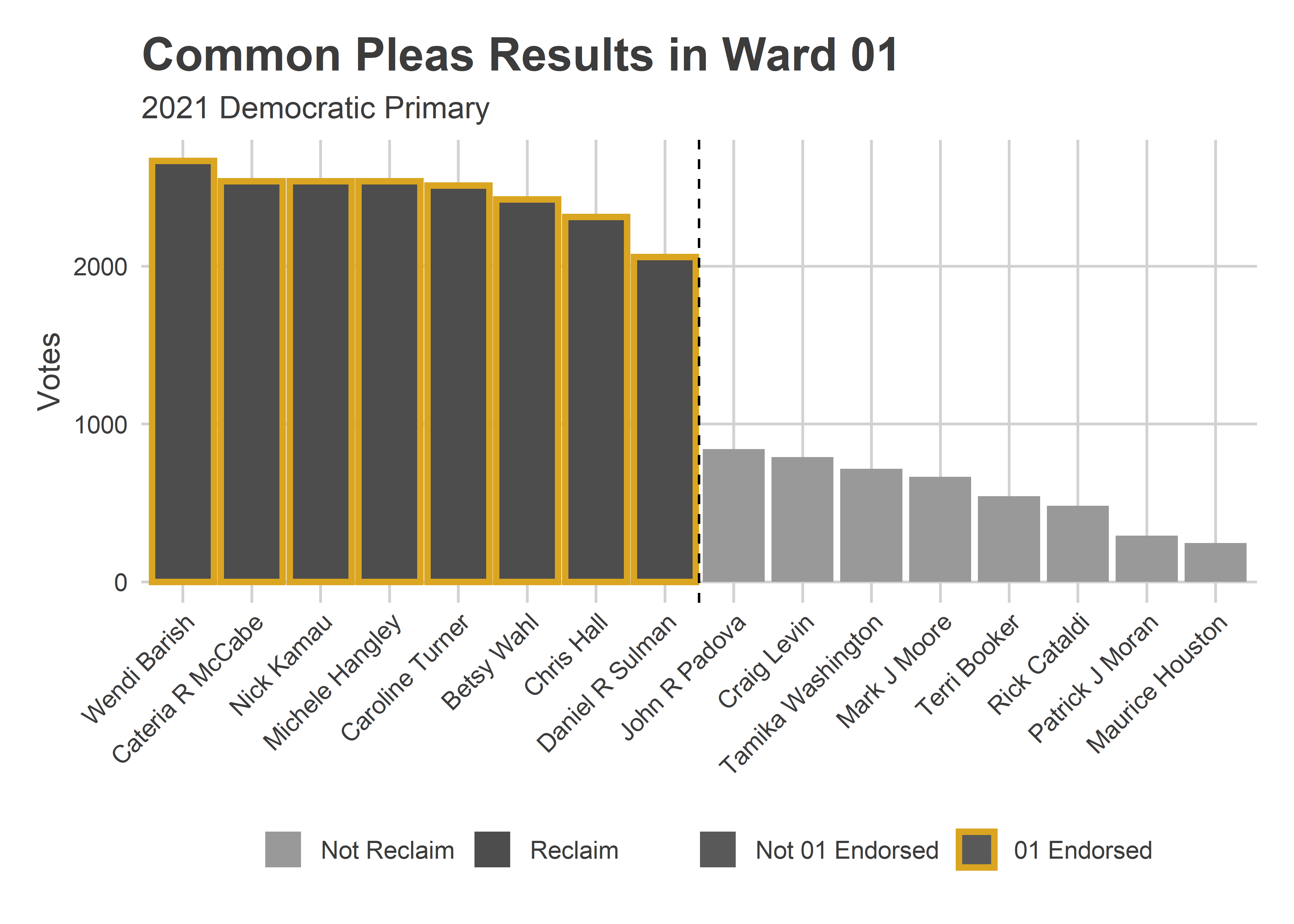
It’s usually impossible to separate the many overlapping endorsements. Was it the Bar that brought the win, the DCC, or the Ward? But these eight winners are exactly the ward’s endorsed candidates. They were also the full Reclaim slate, so it’s impossible to separate the Ward’s power from Reclaim. But the deciding factors were almost certainly these two.
The four wards with the biggest gap between eighth and ninth place–suggesting the strongest slate power–were South Philly’s 1st and 2nd and West Philly’s 27th and 46th.
The 2nd Ward, just to the 1st’s North, had slightly different endorsements than Reclaim. The six candidates who had both a Reclaim and 2nd Ward endorsement did best. Barish came in seventh with only a Reclaim endorsement, Levin in eighth with only the 2nd, and Sulman in ninth with only Reclaim.
View code
ward_bar(
"02",
c("Hall", "Hangley", "Kamau", "Levin", "McCabe", "Turner", "Wahl")
) 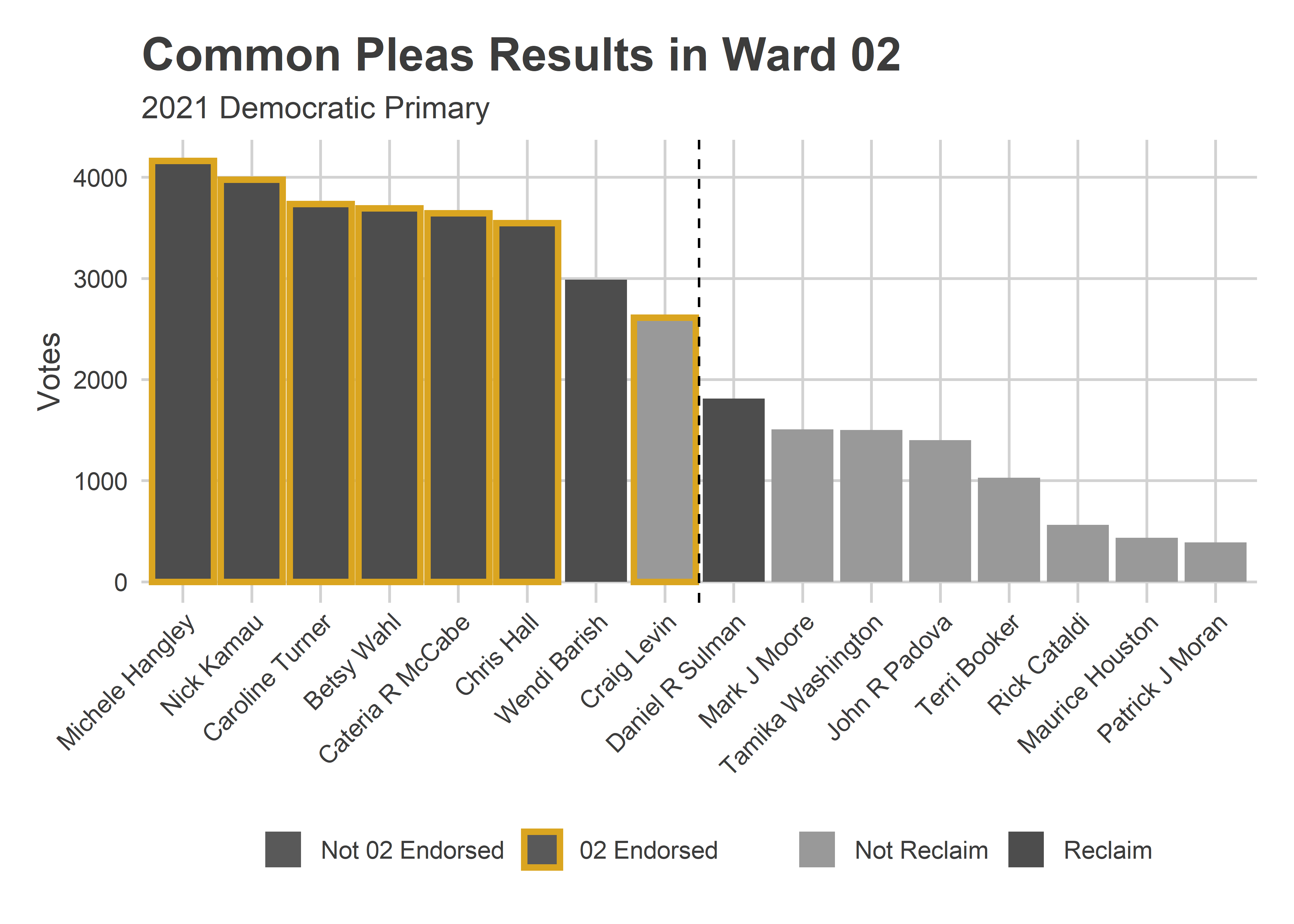
In the 27th (where, full disclosure, I’m a committeeperson), the Reclaim endorsements appear to have carried the day: Turner and Hall won, while 27-endorsed Moore and Levin didn’t.
View code
ward_bar(
"27",
c("Barish", "Moore", "Hangley", "Kamau", "Levin", "McCabe", "Sulman", "Wahl")
)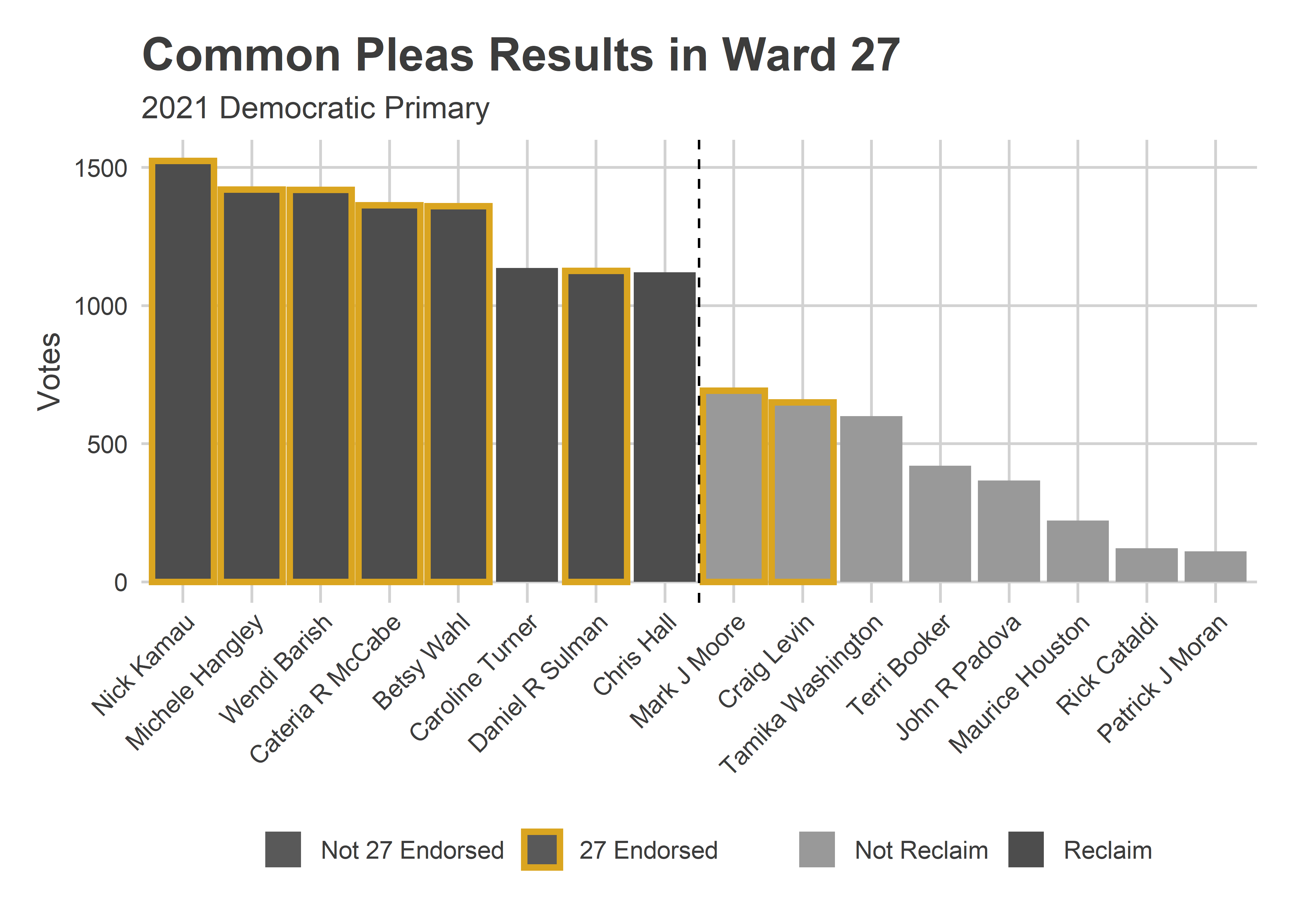
I haven’t found the 46th ward endorsements, but the Reclaim slate cleaned up.
View code
ward_bar(
"46",
c()
) + labs(subtitle="2021 Primary. Endorsements not available.")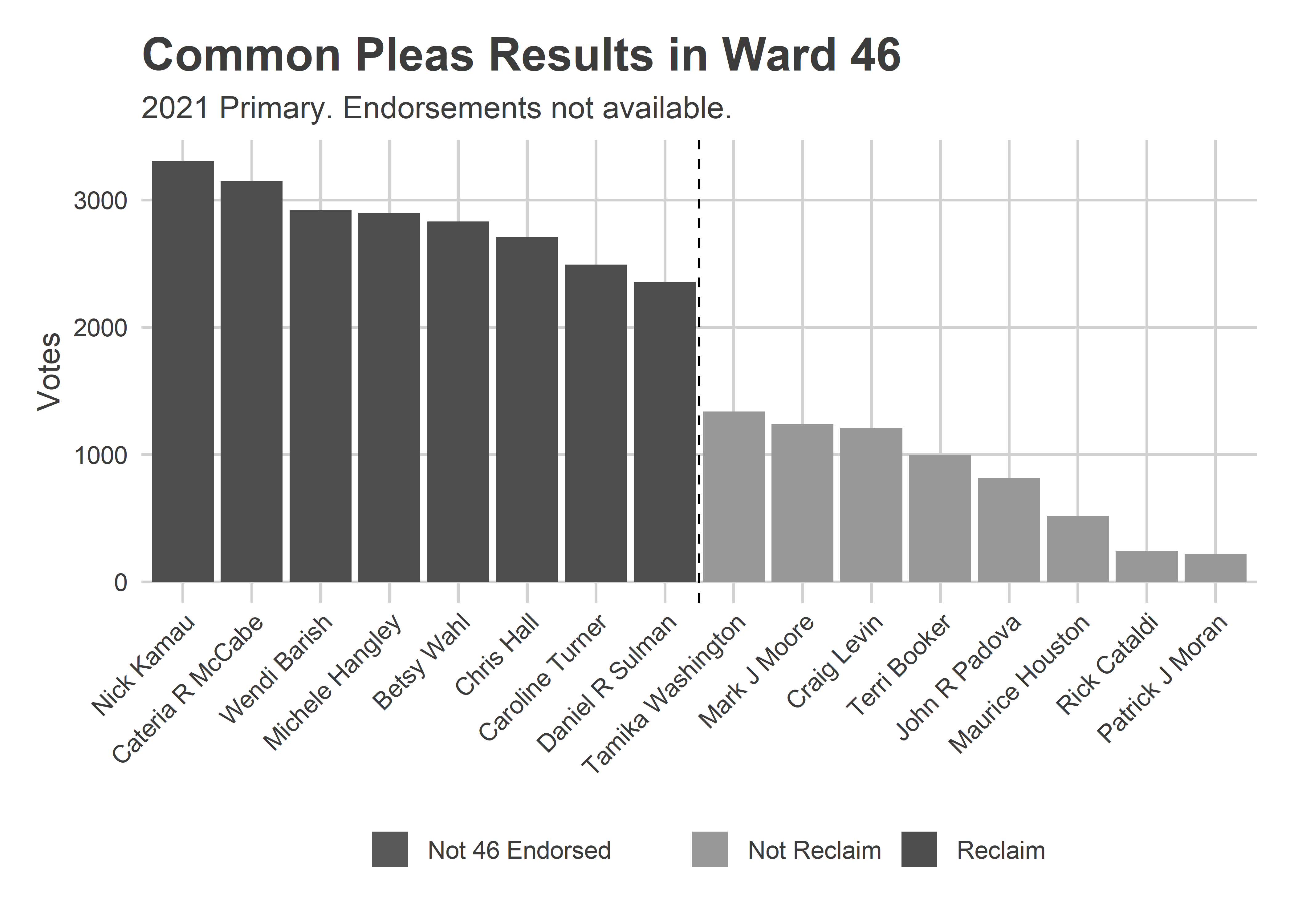
Not only was the Reclaim slate particularly strong in these wards, but the gap between eighth and ninth position make it clear it was the Reclaim endorsement itself, and not one of the other pregressive slates that drove voters.
But the Reclaim endorsement wasn’t itself enough to win across the city. Caroline Turner came in ninth despite it and first ballot position, mostly due to poor results in the Black wards.
Wealthy Progressive divisions did consolidate their votes in a way other divisions didn’t. Grouping divisions by my Voting Blocs shows that the Wealthy Progressive divisions’ preferred candidates did better there than the preferred candidates of other blocs’.
View code
devtools::load_all("C:/Users/Jonathan Tannen/Dropbox/sixty_six/posts/svdcov/")
svd_time <- readRDS("../../data/processed_data/svd_time_20210813.RDS")
div_cats <- get_row_cats(svd_time, 2020)
# ggplot(divs %>% left_join(div_cats, by=c("warddiv"="row_id"))) +
# geom_sf(aes(fill=cat), color=NA)
res_cat <- res_cp %>% left_join(div_cats, by=c("division"="row_id")) %>%
filter(!is.na(name)) %>%
group_by(name, cat) %>%
summarise(votes=sum(votes)) %>%
group_by(cat) %>%
mutate(
rank = rank(desc(votes)),
pvote=votes/sum(votes)
)
ggplot(res_cat, aes(x=rank, y=100*pvote)) +
geom_bar(stat="identity", fill="grey50") +
facet_grid(cat ~ .) +
geom_text(
aes(label=gsub(".* ([A-Za-z]+)$", "\\1", name)),
y=0.3,
angle=90,
hjust=0
)+
theme_sixtysix() +
geom_vline(xintercept=8.5, linetype="dashed") +
labs(x="Rank", y="% of Vote", title="Results by Division Bloc")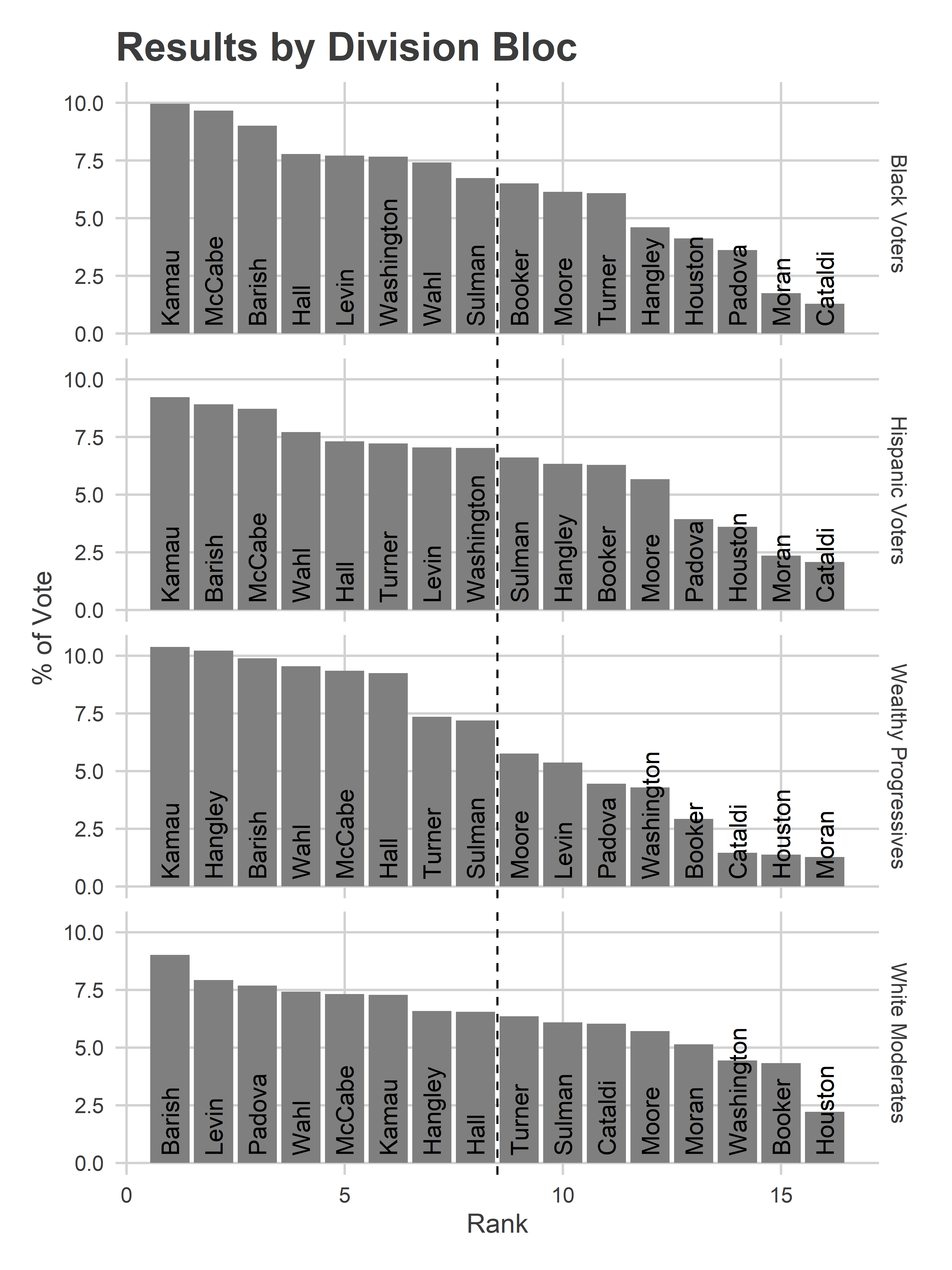 The top eight candidates in the Wealthy Progressive divisions received on average 9.1% of the vote, compared to 8.2% in the Black Voter divisions, 7.9% in the Hispanic Voter, and 7.5% in the White Moderate. To measure another way, Common Pleas candidates had a gini coefficient of votes of 0.29 in Wealthy Progressive divisions, compared to 0.22, 0.19, and 0.14 in the other three blocs, indicating greater inequality in the votes candidates received, and thus more separation.
The top eight candidates in the Wealthy Progressive divisions received on average 9.1% of the vote, compared to 8.2% in the Black Voter divisions, 7.9% in the Hispanic Voter, and 7.5% in the White Moderate. To measure another way, Common Pleas candidates had a gini coefficient of votes of 0.29 in Wealthy Progressive divisions, compared to 0.22, 0.19, and 0.14 in the other three blocs, indicating greater inequality in the votes candidates received, and thus more separation.
This is probably due to voters there being more likely to look up recommendations either on or before election day, and having consolidated preferences.
View code
gini <- function(x){
outer_sum <- outer(x, x, FUN="-")
gini <- sum(abs(outer_sum)) / (2 * length(x)^2 * mean(x))
return(gini)
}
# res_cat %>%
# group_by(cat) %>%
# summarise(
# gini = gini(pvote),
# mean=mean(pvote[rank <= 8])
# )Mail-In Votes
Entering this election, I was especially interested if mail-in ballots would have different dynamics than in-person voting. When people vote at the kitchen table, likely over days, will ballot position matter less? Will endorsements matter more?
In total, 33% of the votes for CP came by Mail, vs 66% on Election Day (and 1% Provisionals). The Wealthy Progressive divisions were more likely to use mail: 38% of their votes were by mail, compared to 34% in the White Moderate divisions, and 29 and 28% in the Black and Hispanic Voter divisions.
View code
# res_cp %>% group_by(vote_type) %>%
# summarise(votes=sum(votes)) %>%
# mutate(pct=votes/sum(votes))
#
# res_cp %>%
# left_join(div_cats, by=c("division"="row_id")) %>%
# group_by(cat, vote_type) %>%
# summarise(votes=sum(votes)) %>%
# group_by(cat) %>%
# mutate(pct=votes/sum(votes))The candidates who did better by mail were all in the bottom right of the ballot. The top three were also Highly Recommended, suggesting that endorsements were more likely to be looked up by people voting by mail.
View code
res_votetype <- res_cp %>%
filter(!is.na(name)) %>%
group_by(vote_type, name, rownumber, colnumber, philacommrec, dcc) %>%
summarise(votes=sum(votes)) %>%
group_by(vote_type) %>%
mutate(pvote=votes/sum(votes)) %>%
group_by(name) %>%
mutate(votes_total=sum(votes)) %>%
ungroup() %>%
pivot_wider(names_from=vote_type, values_from=c(votes, pvote)) %>%
mutate(pvote_total=votes_total / sum(votes_total)) %>%
arrange(desc(pvote_Mail - `pvote_Election Day`))
ggplot(
res_votetype %>% arrange(votes_total) %>% mutate(winner = rank(-votes_total) <= 8) %>%
mutate(diff=pvote_Mail - `pvote_Election Day`),
aes(y=rownumber, x=colnumber)
) +
geom_tile(
aes(fill=100*diff),
size=2
) +
geom_text(
aes(
label = ifelse(philacommrec==1, "R", ifelse(philacommrec==2,"HR","")),
x=colnumber+0.45,
y=rownumber+0.45
),
color="grey70",
hjust=1, vjust=0
) +
geom_text(
aes(
label = ifelse(dcc==1, "D", ""),
x=colnumber-0.45,
y=rownumber+0.45
),
color="grey70",
hjust=0, vjust=0
) +
geom_text(
aes(
label = sprintf("%s\n%s%0.1f%%, (%0.1f%% - %0.1f%%)", name, ifelse(diff>0, "+", "-"),100*abs(diff), 100*pvote_Mail,100* `pvote_Election Day`)
),
color="black"
# fontface="bold"
) +
scale_y_reverse(NULL) +
scale_x_continuous(NULL)+
scale_fill_viridis_c(guide=FALSE) +
annotate(
"text",
label="R = Recommended\nHR = Highly Recommended\nD = DCC Endorsed",
x = 1.6,
y = 6,
hjust=0,
vjust=0.5,
color="grey70"
) +
theme_sixtysix() %+replace%
theme(
panel.grid.major=element_blank(),
axis.text=element_blank()
) +
ggtitle(
"Common Pleas: Mail minus In Person.",
"2021 Democratic Primary, arranged as on the ballot."
)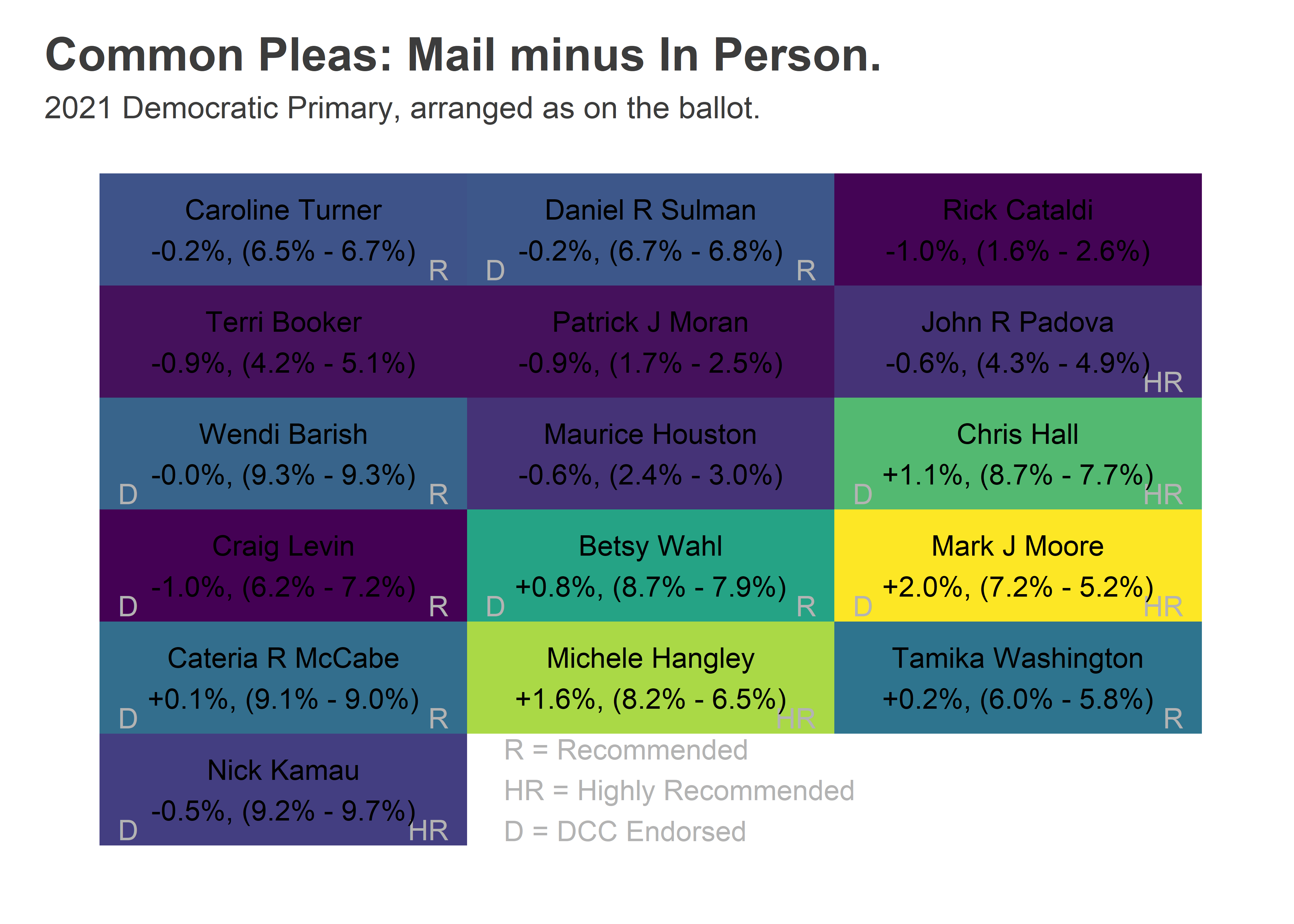
Some of these differences are due to differential rates of mail-in usage: Moore, Hangley, and Wahl all did better in Wealthy Progressive wards, and they mailed in more often. We can adjust that by taking the within-Division difference for each candidate, and then taking a weighted average across divisions weighted by total votes. This decomposition leads to basically the same finding but slightly smaller effects: Moore did 1.9 percentage points better by mail within a given division, Hangley 1.2, and Hall 0.9.
Some of this may still be because the mail voters were systematically different from in-person voters, but this within-division comparison is the closest we can get with the available data.
Doing the decomposition by Voting Bloc is interesting. Moore does better everywhere by mail than in person, probably reflecting the important DCC and Bar effects but a lack of endorsements with Election Day presence. In every bloc, the highest differences are the poor-ballot-position, Bar-recommended candidates. Interestingly, the largest differences are in the White Moderate divisions (South Philly and the Northeast), probably reflecting the politicized nature of mail-in voting, and that in those divisions there were political differences between those who voted by mail and in person.
View code
res_votetype_weighted <- res_cp %>%
select(division, name, vote_type, votes) %>%
filter(!is.na(name)) %>%
group_by(division, vote_type) %>%
mutate(pvote=votes/sum(votes)) %>%
group_by(division) %>%
mutate(total_votes=sum(votes)) %>%
select(-votes) %>%
pivot_wider(names_from=vote_type, values_from=pvote) %>%
mutate(diff = `Mail` - `Election Day`) %>%
group_by(name) %>%
summarise(
diff=weighted.mean(diff, w=total_votes, na.rm = T)
)
res_votetype_weighted_cat <- res_cp %>%
select(division, name, vote_type, votes) %>%
filter(!is.na(name)) %>%
group_by(division, vote_type) %>%
mutate(pvote=votes/sum(votes)) %>%
group_by(division) %>%
mutate(total_votes=sum(votes)) %>%
select(-votes) %>%
left_join(div_cats, by=c("division"="row_id")) %>%
pivot_wider(names_from=vote_type, values_from=pvote) %>%
mutate(diff = `Mail` - `Election Day`) %>%
group_by(name, cat) %>%
summarise(
diff=weighted.mean(diff, w=total_votes, na.rm = T)
)
ggplot(
res_votetype_weighted_cat %>% group_by(cat) %>%
mutate(rank=rank(desc(diff))),
aes(x=rank, y=100*diff)
) +
geom_bar(stat="identity") +
facet_grid(cat~.) +
theme_sixtysix() +
geom_text(aes(label= gsub(".* ([A-Za-z]+)$", "\\1", name)), angle=90, hjust=0, y=0.1)+
labs(
title="Mail minus In-Person Results", subtitle="By Voting Bloc",
y="Mail % minus In-Person %",
x=NULL
)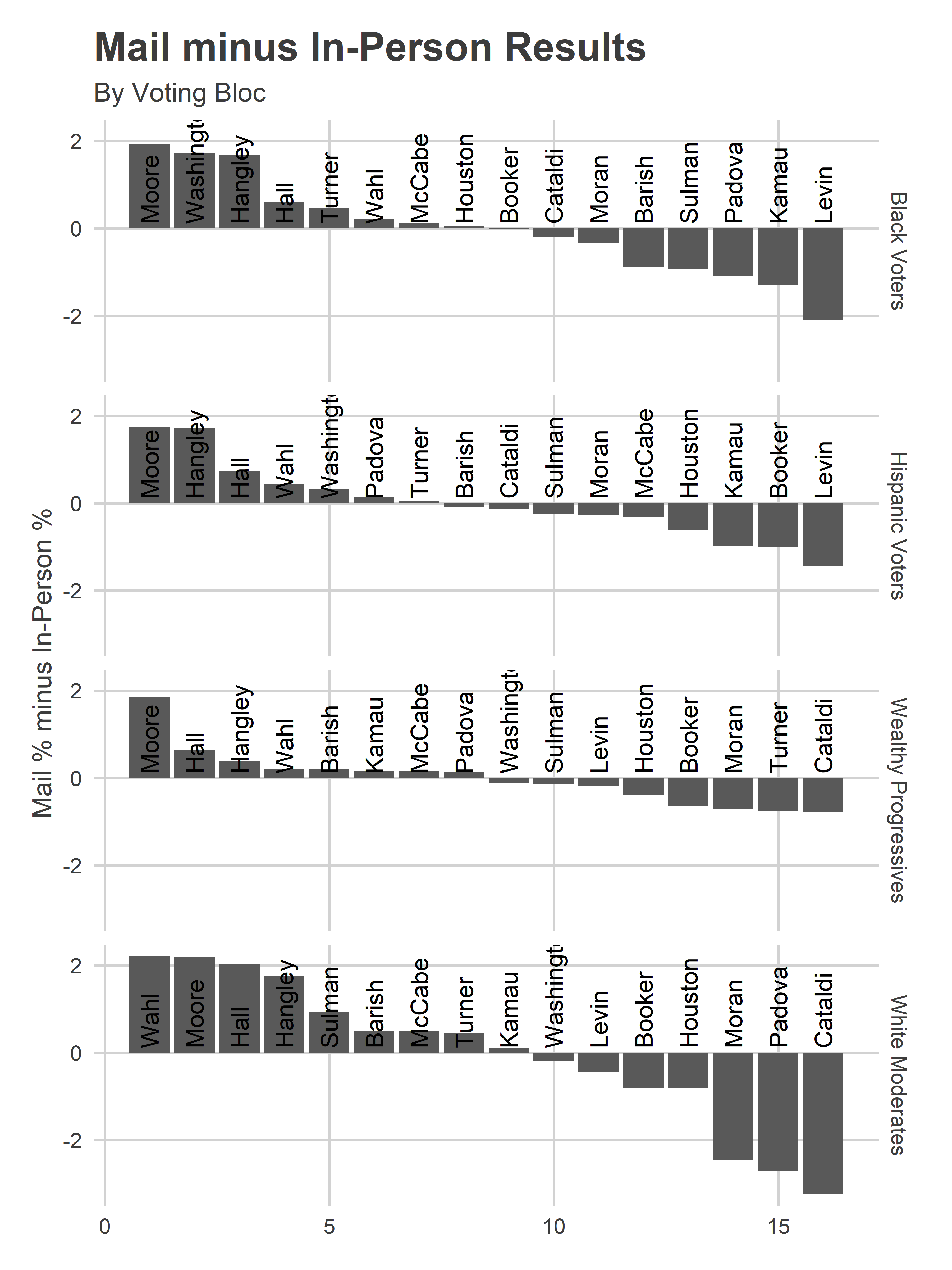
Next: The Effect of the Bar Recommendations!
Coming soon.
How many Republicans became Democrats? Just over 6,000.
In my piece on the DA’s race, I didn’t discuss one of the most discussed aspect of this race, Vega’s work to get Republicans to switch to Democrats, to be able to vote in the closed Primary.
All in all, 6,384 voters had switched their registration from Republican to Democrat since November. That number was 2,006 in 2019, so we certainly have seen a dramatic increase. In an election where we’ll see fewer than 150,000 voters, that’s not nothing. It could swing the election if it’s within a few points.
Note on the data: I only have registration data from an assortment of dates where I happened to buy it, so this isn’t exactly apples to apples. I’ll be comparing today with 2020-10-19, and then 2019-06-24 with 2018-08-06. But the registration data does contain “last changed date”, so I can sanity check the results, and this date mismatch doesn’t appear to make a big difference.
View code
library(dplyr)
library(tidyr)
library(ggplot2)
library(sf)
devtools::load_all("../../admin_scripts/sixtysix/")
fve_names <- read.csv("../../data/voter_registration/col_names.csv")
read_fve <- function(ds){
path <- sprintf(
"../../data/voter_registration/%1$s/PHILADELPHIA FVE %1$s.txt",
ds
)
fve <- readr::read_tsv(
path,
col_types = paste0(rep("c", nrow(fve_names)), collapse=""),
col_names = as.character(fve_names$ï..name)
) %>%
mutate(
party = case_when(
`Party Code` %in% c("D", "R", NA) ~ as.character(`Party Code`),
TRUE~"Oth"
),
)
fve
}
lagged_fve <- function(first, second){
first <- read_fve(first)
second <- read_fve(second)
second <- second %>%
left_join(
first %>% select(`ID Number`, party, `Street Name`),
by="ID Number",
suffix=c(".1", ".0")
) %>%
mutate(
party_switch = paste0(party.0, "_", party.1),
ward = substr(`Precinct Code`, 1, 2),
warddiv = paste0(ward, "-", substr(`Precinct Code`, 3, 4))
)
second
}
fve_19 <- lagged_fve("20180806", "20190624")
fve_21 <- lagged_fve("20201019", "20210510")
fve_21 %>% with(table(party.0, party.1, useNA="always"))
fve_19 %>% with(table(party.0, party.1, useNA="always"))
ward_reg_21 <- fve_21 %>%
group_by(ward, party_switch) %>%
summarise(n=n())
ward_reg_19 <- fve_19 %>%
group_by(ward, party_switch) %>%
summarise(n=n())
wards <- st_read("../../data/gis/warddivs/201911/Political_Wards.shp") %>%
mutate(ward=sprintf("%02d", as.numeric(as.character(WARD_NUM))))ggplot(
wards %>%
left_join(
bind_rows(
`2021`=ward_reg_21 %>% filter(party_switch=="R_D"),
`2019`=ward_reg_19 %>% filter(party_switch=="R_D"),
.id="year"
)
)
) +
geom_sf(
aes(fill=n),
color=NA
) +
scale_fill_viridis_c() +
facet_wrap(~year) +
theme_map_sixtysix() %+replace%
theme(legend.position = "right") +
labs(
title="Registration Switches R -> D",
fill="Count"
)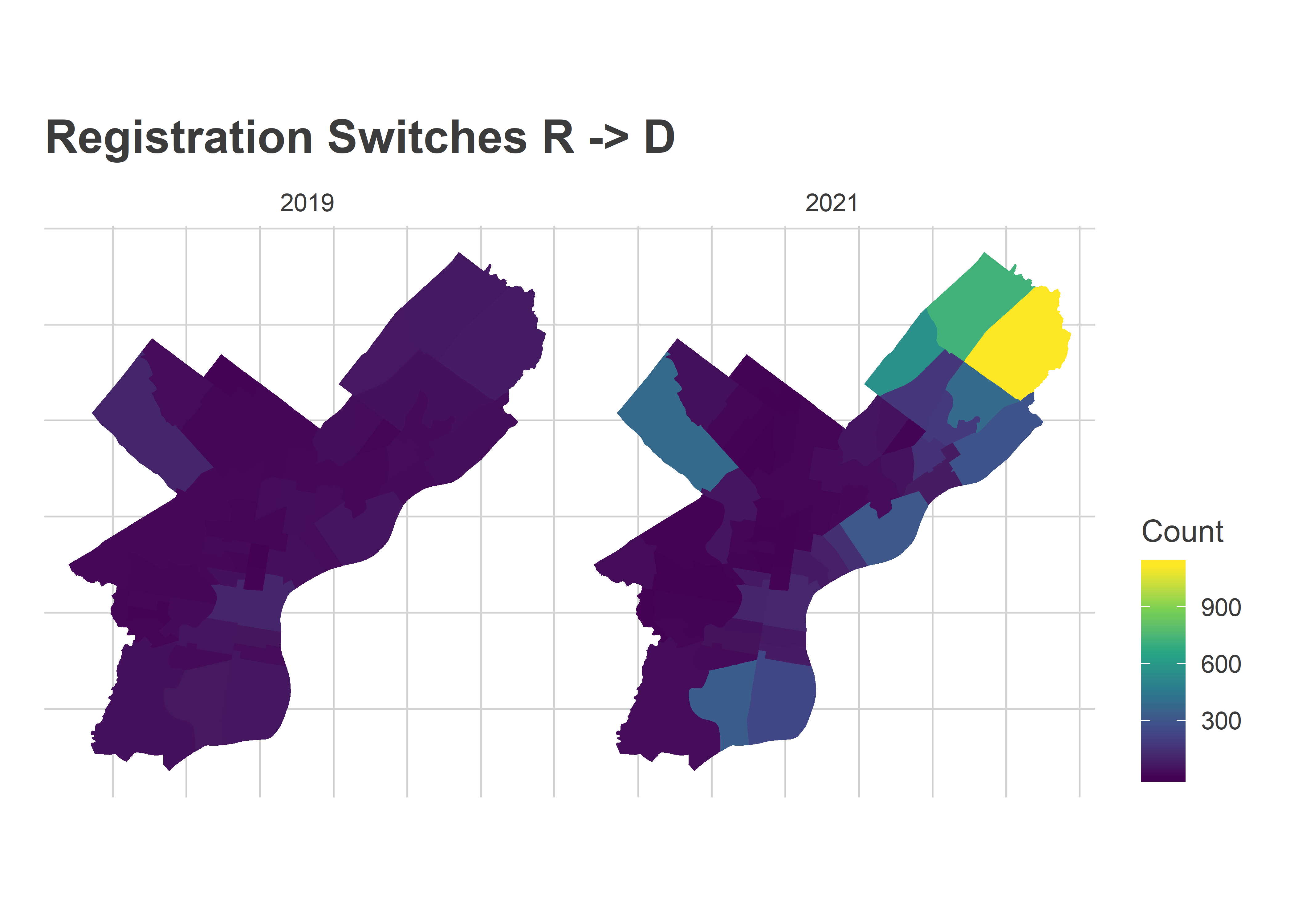 To put the number in perspective, compare it to the total number of Democratic new registrants who weren’t registered in Philadelphia in November (they either moved from elsewhere, or are new voters).
To put the number in perspective, compare it to the total number of Democratic new registrants who weren’t registered in Philadelphia in November (they either moved from elsewhere, or are new voters).
View code
ggplot(
wards %>%
left_join(
ward_reg_21 %>%
filter(party_switch %in% c("NA_D", "R_D")) %>%
mutate(party_switch = case_when(
party_switch == "NA_D" ~ "New Dem",
party_switch == "R_D" ~ "Rep -> Dem"
))
)
) +
geom_sf(
aes(fill=n),
color=NA
) +
scale_fill_viridis_c() +
facet_wrap(~party_switch) +
theme_map_sixtysix() %+replace%
theme(legend.position = "right") +
labs(
title="Party Changes, 2021",
fill="Count"
)
Despite high number of transitions in the Northeast, overall new registrants who are Dems greatly outnumber Rep to Dem switches. But that gap is smaller than in 2019. (Comparing 2021 to 2019 isn’t exactly apples-to-apples, since we’re now coming off a Presidential election and a lot more people probably registered last summer than summer 2018.)
View code
ggplot(
bind_rows(
`2021`=ward_reg_21,
`2019`=ward_reg_19,
.id="year"
) %>%
filter(party_switch %in% c("NA_D", "R_D")) %>%
mutate(party_switch = case_when(
party_switch == "NA_D" ~ "Not Registered -> Dem",
party_switch == "R_D" ~ "Rep -> Dem"
)) %>%
group_by(party_switch, year) %>%
summarise(n=sum(n), .groups = "drop") %>%
arrange(desc(n)) %>%
mutate(party_switch = factor(party_switch, levels=unique(party_switch))),
aes(x=party_switch, y=n)
) +
geom_col(
aes(group=year, fill=year),
position="dodge"
) +
scale_fill_manual(
values=c(
`2021`=colors_sixtysix()$light_blue,
`2019`=colors_sixtysix()$light_green
),
guide=FALSE
) +
theme_sixtysix() +
annotate(
"text",
x=c(1-0.45/2,1+0.45/2,2-0.45/2,2+0.45/2),
y=0,
vjust=-0.1,
label=c(2019, 2021, 2019, 2021)
) +
labs(
title="Party Registration Changes",
x=NULL,
y="Count of registrants"
)